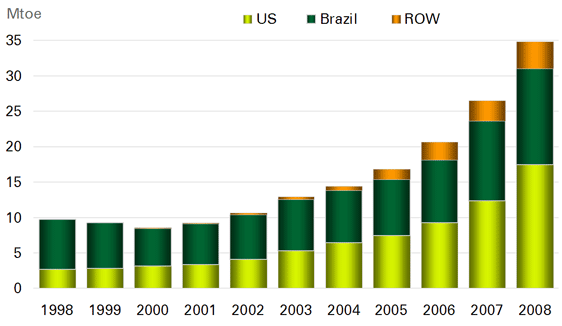Team:UNICAMP-Brazil/Yeastguard/Why
From 2009.igem.org
| Line 6: | Line 6: | ||
<p style=”text-align:justify;”>Despite the pros and cons of the use of ethanol as a possible substitute to the oil derivates, its global production increased 31% in 2008 (6), reaching the mark of 35 million tons of oil equivalent (1.2 million barrels daily on a volumetric basis), as shown in figure 1.</p> | <p style=”text-align:justify;”>Despite the pros and cons of the use of ethanol as a possible substitute to the oil derivates, its global production increased 31% in 2008 (6), reaching the mark of 35 million tons of oil equivalent (1.2 million barrels daily on a volumetric basis), as shown in figure 1.</p> | ||
| - | [[Image:Graph_Yeast_Why_1.png]] | + | [[Image:Graph_Yeast_Why_1.png |center]] |
<p style="text-align:justify;font-size:0.9em;">Figure 1: This bar chart shows global fuel ethanol production in million tons oil equivalent (Mtoe) from 1998 to 2008. Brazil, US and Other are depicted. The US has shown the greatest increase in ethanol production from 2.64 Mtoe in 1998 to 17.46 in 2008. Brazil’s ethanol production has increased from 7.05 in 1998 Mtoe to 13.55 Mtoe in 2008. Other has grown form 0 to 3.79 Mtoe over the period (adapted from “Statistical Review of World Energy 2009”).</p> | <p style="text-align:justify;font-size:0.9em;">Figure 1: This bar chart shows global fuel ethanol production in million tons oil equivalent (Mtoe) from 1998 to 2008. Brazil, US and Other are depicted. The US has shown the greatest increase in ethanol production from 2.64 Mtoe in 1998 to 17.46 in 2008. Brazil’s ethanol production has increased from 7.05 in 1998 Mtoe to 13.55 Mtoe in 2008. Other has grown form 0 to 3.79 Mtoe over the period (adapted from “Statistical Review of World Energy 2009”).</p> | ||
| - | + | A<p style=”text-align:justify;”>lthough US is still the major producer of ethanol, Brazilian´s production is also increasing and presents a big advantage compared to the American maize derivate: its relative inexpensive production costs. As shown in figure 2, the increase in Brazilian production is followed by a decrease in its production costs, allowing ethanol to be competitive with gasoline in our intern market (7).</p> | |
FIGURA | FIGURA | ||
| - | Figure 2: Production and cots of ethanol in Brazil (adapted from D. L. Gazzoni). | + | <p style="text-align:justify;font-size:0.9em;">Figure 2: Production and cots of ethanol in Brazil (adapted from D. L. Gazzoni).</p> |
| - | Despite the big success of the ethanol production in our country, there are lots of things that can be done to make it more efficient and less expensive, and we believe that the use of synthetic biology could be extremely helpful in order to reach these goals. So, these facts encouraged us to develop an iGEM project related to the improvement of ethanol production. | + | <p style=”text-align:justify;”>Despite the big success of the ethanol production in our country, there are lots of things that can be done to make it more efficient and less expensive, and we believe that the use of synthetic biology could be extremely helpful in order to reach these goals. So, these facts encouraged us to develop an iGEM project related to the improvement of ethanol production.</p> |
| - | How ethanol is produced in Brazil? | + | =How ethanol is produced in Brazil?= |
| - | As previously reported, sugar cane is used as a substrate to ethanol production in Brazil. Two major components of plants, starch and cellulose, are both made up of sugars, and can in principle be used as a substrate for fermentation. However, only the sugar portions can be economically converted nowadays (5). | + | <p style=”text-align:justify;”>As previously reported, sugar cane is used as a substrate to ethanol production in Brazil. Two major components of plants, starch and cellulose, are both made up of sugars, and can in principle be used as a substrate for fermentation. However, only the sugar portions can be economically converted nowadays (5).</p> |
| - | In factories that produce ethanol, the cane juice is heated up to 110° C to reduce microbial contamination, decanted, sometimes concentrated by evaporation and then fermented by Saccharomyces cerevisiae. After the fermentation, yeasts are separated from the fermented medium by centrifugation and reused in subsequent fermentations after dilute-sulphuric-acid washing to reduce bacterial contamination. The fermented liquor is distilled, producing a constant-boiling (azeotropic) mixture of hydrous ethanol at 95.5% v/v (1). | + | <p style=”text-align:justify;”>In factories that produce ethanol, the cane juice is heated up to 110° C to reduce microbial contamination, decanted, sometimes concentrated by evaporation and then fermented by Saccharomyces cerevisiae. After the fermentation, yeasts are separated from the fermented medium by centrifugation and reused in subsequent fermentations after dilute-sulphuric-acid washing to reduce bacterial contamination. The fermented liquor is distilled, producing a constant-boiling (azeotropic) mixture of hydrous ethanol at 95.5% v/v (1).</p> |
| - | Since ethanol production occurs in big opened vats, the strategies adopted to avoid contamination (as heat the cane juice and wash the yeasts with sulphuric-acid) are not enough to guarantee a sterile environment. This is a huge problem since contaminants compete with the yeast during the fermentation, decreasing the efficiency of ethanol production. This decrease in efficiency due to the presence of contaminants causes big losses to the producers. This way, we decided to work on this subject on our iGEM project. | + | <p style=”text-align:justify;”>Since ethanol production occurs in big opened vats, the strategies adopted to avoid contamination (as heat the cane juice and wash the yeasts with sulphuric-acid) are not enough to guarantee a sterile environment. This is a huge problem since contaminants compete with the yeast during the fermentation, decreasing the efficiency of ethanol production. This decrease in efficiency due to the presence of contaminants causes big losses to the producers. This way, we decided to work on this subject on our iGEM project.</p> |
Revision as of 18:19, 21 October 2009
| ||||||||||||||||||||||||||||||||||
 "
"















